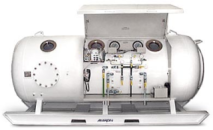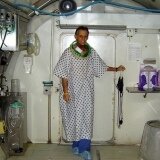About HBOT Indications

The HBOT benefits and positive scientific evidence lent credibility to the employment of Hyperbaric Oxygen Therapy worldwide.218
Unfortunately by the late 1970s, the tendency of unprofessional and often indiscriminate use of the Hyperbaric Oxygen Treatment was recognized. For a variety of reasons some practitioners were searching to cure anything by Hyperbaric Chambers.
In order to prevent backlash from the strict scientific approach and protect patients from indiscriminate use, professional hyperbaric organizations had to establish guidelines for the employment of Hyperbaric Therapy.
As a result, the US based Undersea and Hyperbaric Medical Society (UHMS), formed in 1967, was the first to formulate the official definition and approved indications list for HBO treatment.
UHMS definition of Hyperbaric Oxygen Therapy
"The patient breathes 100% oxygen intermittently while the pressure of the treatment chamber is increased to greater than one atmosphere absolute (atm abs). Current information indicates that pressurization should be at least 1.4 atm abs. This may occur in a single person chamber (monoplace) or multiplace chamber (may hold 2 or more people). Breathing 100% oxygen at 1 atm abs or exposing isolated parts of the body to 100% oxygen does not constitute HBO2 therapy."
HBOT Indications approved by UHMS Hyperbaric Oxygen Therapy Committee
- Air or Gas Embolism
- Carbon Monoxide Poisoning / Cyanide Poisoning
- Clostridial Myositis and Gas Gangrene (Clostridial Myonecrosis)
- Crush Injury, Compartment Syndrome, and other Acute Traumatic Ischemias
- Decompression Sickness
- Enhancement of Healing in Selected Problem Wounds
- Exceptional Blood Loss (Anemia)
- Intracranial Abscess
- Necrotizing Soft Tissue Infections
- Osteomyelitis (Refractory)
- Delayed Radiation Injury (Soft Tissue and Bony Necrosis)
- Skin Grafts & Flaps (Compromised)
- Thermal Burns
The list of medical conditions treated by HBOT internationally is much wider. In USA and Europe they are referred to as off-label indications. Often these are not reimbursed by insurance as being categorized as Investigational.
Investigational HBOT indications (often called Off-Label indications)
-
Autoimmunity Related Disorders
- Chronic Fatigue Syndrome
- Fibromyalgia
- Lupus
- Scelodrema
- Silicone induced disorders
- Guillain-Barre syndrome
- Rheumatoid Arthritis
-
Cardiac Disorders
- Heart attack, Myocardial ischemia
- Aid to cardiac surgery and rehabilitation
-
Endocrine Disorders
- Diabetes
-
Gastrointestinal
- Colitis
- Crohns Disease
- Gastric and Duodenal Ulcers
-
Hematology
- Acute and Chronic Anemia
-
Neurological Disorders
- Candidas and fungal infections
- Hypoxic birth disorders
- Parkinsons disease
- Spinal Cord injury
- AIDS
- Autism Spectrum Disorders
- Cerebral edema
- Cerebral Palsy, epilepsy due to hypoxia
- Chemical Poisoning (e.g. Pesticide)
- Flesh eating bacteria
- Headaches, Cluster
- Lyme disease
- Migraine
- Multiple Sclerosis
- Mycoplasma
- Near drowning
- Near hanging
- Neurovascular compression
- Peripheral nerve injury and neuropathies, demyelination
- RSD
- Spider bite
- Stroke
- TOS
- Vegetative coma
-
Ophthalmology
- Macular degeneration
- Retintis Pigmentosa
-
Orthopedic Disorders
- Bone Grafts
- Fracture repair, delayed and non-union
- Inflammatory arthritis
- Osteoporosis
- Post surgical instability
- Sacroiliac Syndrome
- Aid to prosthesis rehabilitative care
-
Otorhinolaryngology
- Acute acoustic Trauma
- Sudden deafness
-
Peripheral Vascular Disorders
- Acute and Chronic arterial insufficiency
- Delayed wounds, recurrent ulcers an infections
-
Plastic and Cosmetic Surgery
- Post surgical soft tissue infections
- Non- healing post surgery, reconstruction and cosmetic surgery
- Pre and Post Surgery healing, reconstruction and cosmetic surgery
-
Traumatology
- Closed head injury
- Compartmental syndrome
- Soft tissue musculoskeletal injuries
Contraindications to HBOT
Studies and clinical evidence of last decades have provided enough data confirming positive physiologic effects of Hyperbaric Oxygen Therapy (HBOT) in a number of health conditions. However like with most drugs, contraindications to Hyperbaric Oxygen Therapy (HBOT) do exist. There are absolute and relative contraindications to HBOT.120
-
Absolute Contraindications
- Untreated Pneumothorax
- Some Selected medications
-
Relative Contraindications
- Congenital Spherocytosis - a strong contraindication, HBOT should be considered only as a critical care measure
- Asthma (medications to be administered to control the condition)
- Chronic Obstructive Pulmonary Disease (COPD) / Bullous Emphysema
- Claustrophobia, Seizures (medications controlling anxiety, insomnia, agitation, seizures , etc.. to be considered, e.i. benzodiazepines)
- Ear or sinus surgery
- Optic neuritis
- Recent thoracic surgery
- Upper Respiratory Infections
- Pacemakers (their technical specifications should be revised prior the treatment to avoid deformation)
Hyperbaric Oxygen Side Effects
Hyperbaric Oxygen Therapy is generally safe and well tolerated. Most side-effects are mild and reversible, although adverse events can occur in rare cases (reversible myopia, symptomatic otic barotraumas, pulmonary barotraumas or pulmonary oxygen toxicity, as well as seizures due to central nervous system oxygen toxicity).236, 237
Here is the list:
- Barotrauma (otic, sinus, pulmonary)
- Claustrophobia
- Oxygen induced seizures and other CNS effects
- Pulmonary oxygen toxicity
- Visual refractive changes
Oxygen Toxicity
Statistics show that breathing densely packed molecular oxygenwhich is precisely what you do when you undergo hyperbaric oxygen therapyis extremely safe. According to Philip James, medical director of the University of Dundees Wolfson Hyperbaric Medicine Unit, Oxygen is the most researched drug on the face of the planet with no known side effects. But if this is true, why the fuss? Read more about oxygen toxicity...












